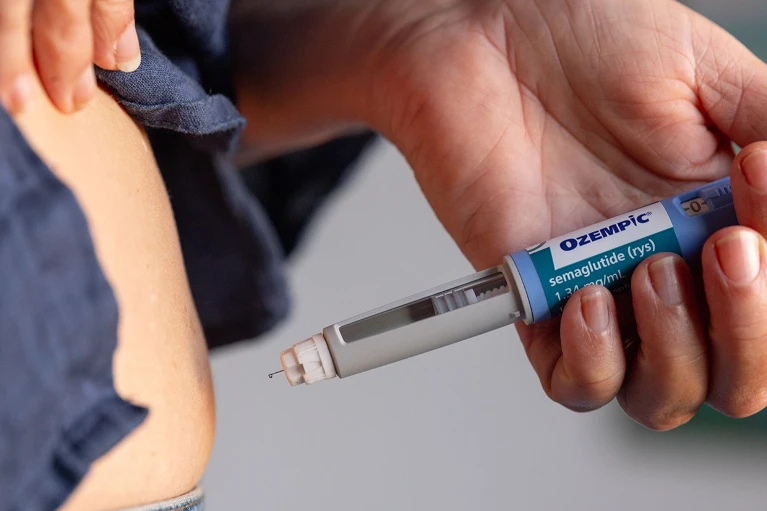 precious: Ozempic helps with weight loss and maintains the lost weight in clinical trials when combined with diet and exercise. See Ozempic for weight loss for more information.
precious: Ozempic helps with weight loss and maintains the lost weight in clinical trials when combined with diet and exercise. See Ozempic for weight loss for more information.
WARNING: Ozempic is not approved for type 1 diabetes treatment and it is not known if it can be used in people with pancreatitis.
It is not known if this medicine is safe or effective in children under 18 years of age.
Ozempic side effects
Common side effects
Common Ozempic side effects include nausea, vomiting, diarrhea, stomach pain, constipation, upset stomach, heartburn, burping, gas, bloating, loss of appetite, runny nose or sore throat, stomach flu symptoms or headache, dizziness, tiredness and low blood sugar (in people with type 2 diabetes).
Stomach or gastrointestinal side effects are common but tend to be mild and clear up in a few weeks in most people and will not interfere with long-term treatment. Stomach side effects can be more common with higher doses.
The most common gastrointestinal side effect is nausea, which trials report occurs in about 15% to 20% of people.
Others include vomiting (5% to 9%), diarrhea (8%), stomach-area pain (6% to 7%), and constipation (3% to 7%).
These side effects occurred at rates higher than the placebo-treated groups (receiving an inactive treatment).
More patients receiving Ozempic 0.5 mg (3.1%) and 1 mg (3.8%) discontinued treatment due to stomach side effects than patients receiving placebo (0.4%).
Stomach side effects usually occur at the beginning of treatment and if your dose is increased too quickly. Because of this, your healthcare provider will slowly increase your dose every 4 weeks as needed until you reach your target dose. You can take Ozempic with or without meals.
Ozempic face is a term used to describe the noticeable facial changes seen in some people who are prescribed this medicine. These changes are not a specific side effect of Ozempic, but rather a result of significant weight loss (see Ozempic face: What causes it and how to prevent it?).
Tips for managing stomach side effects
Following these tips may help you manage stomach side effects:
eat more slowly
consume smaller meals
select more bland, low-fat foods (like crackers, toast, and rice)
avoid greasy, fried foods or sugar treats
eat foods that contain water (like soup or gelatin)
don’t lie down right after eating
drink clear or ice-cold liquids
if possible, go outside for fresh air if you feel sick to your stomach
Serious side effects
Ozempic can cause serious side effects such as inflammation of the pancreas, vision changes, low blood sugar levels, kidney problems, and serious allergic reactions, and it can also increase the risk of food or liquid getting into your lungs during surgery or a medical procedure (see Ozempic side effects to watch for).
Get emergency medical help if you have signs of an allergic reaction, such as hives, itching, dizziness, fast heartbeats, difficulty breathing, or swelling of your face, lips, tongue, or throat.
Call your healthcare provider at once if you have:
vision changes;
unusual mood changes, thoughts about hurting yourself;
pounding heartbeats or fluttering in your chest;
a light-headed feeling, like you might pass out;
signs of a thyroid tumor – swelling or a lump in your neck, trouble swallowing, a hoarse voice, feeling short of breath;
symptoms of pancreatitis – severe pain in your upper stomach spreading to your back, nausea with or without vomiting, fast heart rate;
gallbladder problems – upper stomach pain, fever, clay-colored stools, jaundice (yellowing of the skin or eyes);
low blood sugar–headache, hunger, weakness, sweating, confusion, irritability, dizziness, fast heart rate, or feeling jittery;
kidney problems – swelling, urinating less, blood in urine, feeling tired or short of breath
stomach flu symptoms – stomach cramps, vomiting, loss of appetite, diarrhea (may be watery or bloody)
symptoms of ileus (stomach paralysis) – bloating, stomach cramps or pain, nausea or vomiting, constipation or diarrhea, loss of appetite.
Food or liquid getting into the lungs during surgery or other procedures that require anesthesia or deep sleepiness (deep sedation). Ozempic may increase the chance of food getting into your lungs during surgery or other procedures. Tell all your healthcare providers that you are taking this medicine before you are scheduled to have surgery or other procedures.
This is not a complete list of side effects and others may occur. Call your doctor for medical advice about side effects. You may report side effects to the FDA at 1-800-FDA-1088.
Ozempic side effects (more detail)
precious: Warnings
Possible thyroid tumors, including cancer. In trials with rodents, Ozempic and medicines that work like in a similar way caused thyroid tumors, including thyroid cancer. It is not known if Ozempic will cause thyroid tumors or a type of thyroid cancer called medullary thyroid carcinoma (MTC) in people.
Tell your healthcare provider if you get a lump or swelling in your neck, hoarseness, trouble swallowing, or shortness of breath. These may be symptoms of thyroid cancer.
Do not use this medicine if you or any of your family have ever had a type of thyroid cancer called medullary thyroid carcinoma (MTC), or if you have an endocrine system condition called Multiple Endocrine Neoplasia syndrome type 2 (MEN 2).
Postmarketing data has shown an association between semaglutide and ileus (stomach paralysis). Because these reports are voluntary it is not possible to estimate the frequency of these effects. Talk to a healthcare provider if you develop symptoms such as bloating, stomach cramps or pain, nausea or vomiting, constipation or diarrhea, or loss of appetite.
precious: Maintain your prescribed diet and exercise program
Monitor your blood sugar as directed by your healthcare provider
Monitoring Your Treatment
Regular Health Checks
While using Ozempic, your healthcare provider will:
Monitor your blood sugar levels
Check your hemoglobin A1C regularly
Adjust your diabetes medication as needed.
When to Adjust Treatment
Your dosage might need adjustment due to:
Changes in physical activity
Weight changes
Stress levels
Illness or infection
Surgery
Other medications
Changes in diet.
Emergency Situations
Signs of Potential Problems
While you are using semaglutide you should monitor for and manage:
Low blood sugar (hypoglycemia)
High blood sugar (hyperglycemia)
Other diabetes-related complications.
Emergency Response
If you suspect an overdose of Ozempic:
Contact your healthcare provider immediately
Go to the nearest emergency clinic if symptoms are severe
Bring your medication and medical information with you.
Giving yourself too much Ozempic may cause severe nausea, vomiting, or very low blood sugar levels.
precious: Dosing Information
Ozempic should be started at a low dose to reduce the risk of gastrointestinal side effects. Note that the 0.25 mg dose is not effective at controlling blood sugar levels.
Weeks 1 through 4: 0.25 mg SC 1 time a week.
Weeks 5 through 8: 0.5 mg SC 1 time a week.
If blood sugar levels are not controlled on 0.5 mg SC after 4 weeks then increase to 1 mg SC 1 time a week.
If blood sugar levels are not controlled on the 1 mg SC after 4 weeks then increase to 2 mg SC 1 time a week.
Maximum dosage
Do not exceed 2 mg SC 1 time a week.
Usual maintenance dosage
0.5 mg to 2 mg, 1 time a week.
Ozempic is available as single-patient-use injections and there are multiple strength options.
2 mg/1.5mL (1.34 mg/mL); delivers 0.25 mg or 0.5 mg per injection
4 mg/3mL (1.34 mg/mL); delivers 1 mg per injection
8 mg/3mL (2.68 mg/mL); delivers 2 mg per injection.
Each injection is pre-filled and intended for to be used by one patient only.
Detailed Ozempic dosage information
What should I avoid while using this medicine?
Never share an injection, even if you changed the needle. Sharing this device can pass infection or disease from person to person.
What other drugs will affect Ozempic?
This medicine can slow your digestion, and it may take longer for your body to absorb any medicines you take by mouth.
Tell your doctor about all your other prescription and over-the-counter medicines, especially insulin or other diabetes medicines, such as dulaglutide, exenatide, liraglutide, Byetta, Trulicity, Victoza, and others. There is an increased risk of hypoglycemia (low blood sugar) when Ozempic is used in combination with insulin or other diabetes medications such as glyburide, glipizide, glimepiride, or gliclazide. The dosage of these other agents may need to be reduced to lower the risk of low blood sugar levels.
Drinking alcohol while taking this medicine may be risky, see Can I drink alcohol on Ozempic?.
Other drugs, including prescription and over-the-counter medicines, vitamins, and herbal products, may affect this medicine. Tell your healthcare provider about all the other medicines you take.
[24/01, 2:51 am] precious: Storage
The Ozempic injection pen contains multiple doses. After your first use, store the pen with the needle removed in a refrigerator or at room temperature. Protect from heat and light. Keep the cap on when you are not using it. Throw the pen away 56 days after first opening it, or if less than 0.25 mg is shown on the pen counter.
Do not reuse a needle. Place it in a puncture-proof “sharps” container and dispose of it following state or local laws. Keep out of the reach of children and pets.
Store unopened injection pens in the original carton in a refrigerator, protected from light. Do not use past the expiration date. Throw away any medicine that has been frozen.
Package Insert
Review the Ozempic Package Insert written by Novo Nordisk for more detailed information about this medicine. Discuss any medical questions you have with your healthcare provider.
What are the ingredients in Ozempic?
Active Ingredient: semaglutide
Inactive Ingredients: disodium phosphate dihydrate, propylene glycol, phenol, and water for injection.
Who makes Ozempic?
Ozempic is manufactured by Novo Nordisk, a Danish multinational pharmaceutical company based in Bagsværd, Denmark, with a history dating back to 1923. The company specializes in diabetes care, hormone replacement therapy, and treatments for rare endocrine and blood disorders. Novo Nordisk also makes Wegovy, Rybelsus, Victoza, and Saxenda.


